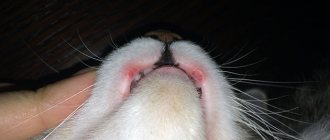Hearing loss in cats can be unilateral or bilateral. If deafness is expressed in only one ear, then the owners may not even realize that the pet has an illness. There is only one way to verify this fact. When your cat is curled up sleeping, make a loud noise. If there is a reaction from the animal, then there is no reason to worry. Check the other ear in the same way when the cat turns over to the other side. Deaf people adapt to life very quickly and are practically no different in behavior from their healthy counterparts.
Most often, white cats with blue eyes are deaf.
How to find out if your kitten or cat is deaf
If the hearing function is impaired in both ears, then this becomes immediately noticeable in the cat’s behavior. She sleeps soundly, without twitching her ears in her sleep. Such animals do not react to noise in any way and are not afraid of loud sounds. They are left indifferent to opening the refrigerator door and opening a bag of food. Even the thunderstorm of many pets does not cause them fear of a vacuum cleaner; on the contrary, deaf pussies even like the air currents it creates. The same signs appear in older cats, but this is caused by senile deafness.
It is believed that cats with hearing loss meow too loudly because they cannot regulate the strength of their voice. But this is not always a sign of deafness.
Interesting! The sound ranges of humans and cats vary greatly. While humans can hear sounds between 20 Hz and 20 kHz, cats hear sounds between 48 Hz and 85 kHz.
How to check if a cat can hear
At home, you can independently test your animal for hearing loss. To do this, it is enough to make a sharp loud sound. A healthy cat will certainly turn around and give a reaction. A deaf cat will not react to a stimulus. To be sure, the animal should not see you; if your hearing is impaired, cats may react not to noise, but to your hand movements or vibrations in the air. The reliability of this method is 95%. If the situation for the cat is very familiar, he sleeps soundly and does not have a fearful disposition, then the faucet may be reluctant to respond to the sound.
You can only get accurate information about whether your pet is deaf at a veterinary clinic. And even then not in every one. To date, a medical test has been developed, which is carried out using special equipment. During its implementation, the frequency and intensity of nerve impulses in the brain that appear as a result of sound exposure are measured. In cats that cannot hear noise, such impulses are completely absent, which proves the presence of deafness. Diagnosis is carried out very rarely; owners often determine the lack of hearing in cats at home quite accurately.
Ear infections, mites and allergies
Ticks can damage the eardrum. Ear mites are a very common disease in cats. Be careful. If a cat scratches its ears and behaves restlessly, it is worth examining it. If you see redness, swelling or a black sticky substance in your ear, this is an alarm, contact your veterinarian immediately. Although these signs may not only indicate the presence of ear mites, they may also indicate the presence of an ear infection.
Food allergies can cause ear infections. If your cat develops an allergy, change the food and contact your veterinarian.
Let's look at some practical tips:
- If your cat sleeps on the floor, then stomp more powerfully so that the floor vibrates, then the cat will feel the approach.
- If your cat sleeps on the bed, rock the edge of the bed to wake your cat.
- If you have a lot of guests, leave the cat indoors.
- Try to provoke a reaction from the cat in any way: vibration, gestures, touch.
- Never leave a deaf cat outside.
- Give your cat a bell and you will always find it in your apartment.
Symptoms of deafness in cats
Congenital deafness does not always appear from the first days of a kitten’s life. Sometimes hearing disappears only after 2-3 weeks. In adult cats, hearing function begins to decline with age. But it’s not for nothing that these animals are famous for their endurance, because they have a very developed compensatory function. When hearing begins to deteriorate, other senses become more acute; they help animals navigate space and catch every movement in it.
But deafness sooner or later becomes clear to the owners themselves, when the animal begins to react differently to familiar situations. For example, if previously it was enough to open the refrigerator door or rustle a bag of food for the fluffy to rush immediately in the hope of getting something tasty, then with a hearing impairment the animal ignores these once attractive sounds. Pussies stop responding to the owner’s call, to which they previously joyfully rushed. In addition, they are not afraid of loud bangs and do not react to noise.
Deafness is not a serious disease unless it is caused by inflammation in the ear. As soon as you suspect your animal has symptoms of hearing loss, you should contact your veterinarian. Or you will be prescribed treatment that will restore your ability to hear. Or they will confirm the presence of deafness and give recommendations on how to care for such an animal.
Types of deafness in cats
There are two main types of deafness in cats:
- conductive;
- neurosensory.
Conductive deafness
It consists in the difficulty of passing sounds through the middle or outer ear, which is why it received another name - conductive. Most often, the cause of its development is diseases or infections that lead to the accumulation of fluid inside the ear, damage to the eardrum, and occlusion of the ear canals. In this case, hearing is only partially lost. With the right treatment, it can be brought back with medication or surgery.
Sensorineural deafness
Often this deafness appears from birth and begins to develop already at the embryonic stage. She is not being treated at all. There are serious inner ear disorders involved. Most often, sensorineural deafness is complete; partial manifestations are very rare. It can also appear in adult cats as a result of age-related destruction.
Is it true that white cats with blue eyes are more likely to be deaf?
This statement may seem like a “horror story,” but in fact this opinion is a very real reflection of reality. Yes, white cats with blue eyes are much more likely than their “polychrome” relatives to be deaf from birth. In addition, they are more likely to become deaf in adulthood.
This is due to recessive genes, which in some animals are associated with either the white color or the blue color of the iris. It is for this reason that many professional breeders prefer not to allow pets with this coloring into breeding.
Interesting! There is an official concept, “white cat deafness.” In such animals, some parts of the inner ear are either not developed at all, or they degrade when the cat is not yet three years old.
Interesting fact. In blue-eyed and white cats, it often happens that one eye has a more pronounced and rich color of the iris. So here it is. It is not known exactly why this happens, but deafness is often caused by the ear on the side of the more “colored” eye. The ear on the opposite side either hears or retains the ability to perceive at least the loudest sounds.
Angora cat and congenital deafness
In principle, we have already described the essence of the problem above. Although not every Angora cat is white (this color is not even the official breed standard), but still “deafness of white cats” is extremely common among them. True, this applies more to animals with blue eyes. Angoras with yellow irises suffer from congenital hearing loss much less frequently.
Important! Deafness can be a sign of an extremely dangerous breed disease, ataxia of Angora cats. It is accompanied by very severe neurodegenerative processes, which often lead to complete or partial paralysis. So, if there is any suspicion of deafness, it is useful to show Angora cats to a veterinarian.
Scottish Fold cats and deafness
Unfortunately, Scottish Folds also often suffer from congenital hearing loss. And if in the case of Angora pets the reason lies in the underdevelopment of some parts of the inner ear, then in the case of the Scots the problem lies in anatomical defects in their development.
Small, neat, slightly “dangling” ears are considered the standard of the breed. Breeders achieved such results through many years of very painstaking selection... as a result of which the genes of numerous hereditary diseases linked with the genes of the “correct” ears.
Deafness is far from the first place among them. However, everything is not so scary. Often deafness among Scots is a consequence of the accumulation of large amounts of sulfur and dirt. These cats are prone to “littering” the ear canals due to their specific structure, so this can often be corrected by carefully monitoring the condition of the hearing organs.
Diagnosis of deafness in cats
The ears have a rather complex structure; only the coordinated work of the eardrum, middle and inner ear helps the animal to hear well. If there is a problem at any of these stages, then hearing is lost. This phenomenon is often observed in older cats due to age-related changes.
Deaf cats are also called “eternal sleepers” because even the loudest sounds that cause a reaction in healthy individuals cannot wake them up. Typically, normal cats react to the appearance of a person in advance, especially if he is not sneaking on tiptoe, but simply walking at a normal pace.
You can check how close you need to get for the animal to hear you. It is necessary to make several such measurements to find out the exact distance from which the pussy begins to hear, since each time it can be different depending on the phase of sleep. The average value is taken as the truth.
Another sure way to determine deafness is to call an animal to you from another room. If the pussy does not respond to the voice, then there is a possibility of decreased hearing function. True, some cats may deliberately ignore you in order to once again demonstrate who is boss.
Only a veterinarian can diagnose “complete deafness” with certain accuracy. A specially developed BAER (Brainstem Auditory) test will help you do this. The procedure is painless for the animal; the main thing is to hold the cat and allow the doctor to attach a special clip with electrodes to the ear. Each ear is studied separately; for this purpose, the second one is plugged with an earphone or a foam insert. Next, an acoustic noise is made and the brain's reaction is checked. A well-hearing cat will have impulses in its brain in response to sound, which will be reflected on the monitor screen. With deafness, the brain does not respond to noise, and therefore impulses do not appear.
Deafness is not a reason to give up an animal. Such pets get along well with their owners and even interact with them, but the reaction is no longer to the voice, but to gestures or facial expressions. The owners of such pussies learn to establish eye contact with them, so man and animal get along well, understanding each other without words.
Prevention and care of the ears: how to prevent the development of deafness
High-quality ear prevention and care will help the owner preserve the pet’s hearing.
You don’t have to do anything particularly complicated for this:
- It is necessary to examine the inside of the ears and the external auditory canal approximately once a week. If sulfur begins to accumulate there, it must be removed. To do this, use ordinary cotton swabs moistened with sterile vegetable or petroleum jelly. At worst, even saline solution (also sterile) will do. All liquids must be heated to approximately 37° Celsius before use.
- If a cat constantly scratches and scratches its ears, and abundant brown deposits are easily visible on the pinnas and in the ear canals themselves, you should immediately treat your pet for otodectosis (ear mites). These parasites often cause severe allergic reactions and, in advanced cases, contribute to the development of severe otitis media. Before using ear drops, you should also carefully remove mite waste in the same way as with regular ear cleaning.
- In long-haired cats, excess hair around the ears should be trimmed periodically. This promotes better ventilation of the ear canals, which prevents the creation of favorable conditions for parasites and pathogenic fungi.
How to care for a deaf cat
Most often, deafness is a feature of cats with white fur and blue eyes. Read the article about whether all white cats are deaf and about the genetics of their deafness.
Such kittens are born with a congenital defect; they learn to live with such features almost from birth. As compensatory functions, their sense of smell, vision and touch develop perfectly. Therefore, their life is practically no different from the life of healthy cats.
If you want to buy a cat with a white coat, you should always remember the risks and be prepared for them. Typically, developmental defects are identified by the breeder himself, who then ensures that the animal does not produce offspring and that the mutant gene does not spread through generations. Owners are warned about the developmental features of their kitten, but this is not a reason to abandon the baby. It is enough to follow only a few rules of care to ensure a comfortable existence for him:
- While the kitten is small, move around the house carefully so as not to accidentally step on it. Remember that he cannot hear your steps.
- Make eye contact with the cat, and pronounce encouragement or reprimand with clear articulation. Later, the cat will get used to it and will begin to understand your address to him by your lips.
- When approaching the cat, create more air vibrations so that he senses your approach. Don't scare your cat by suddenly grabbing him from behind.
- Don't let your cat out of the house alone, there are too many dangers there. Even in a closed garden area, keep the animal in sight.
1111











